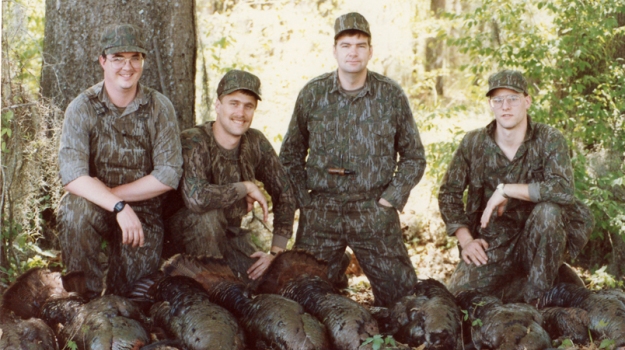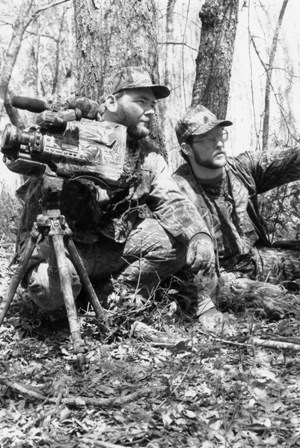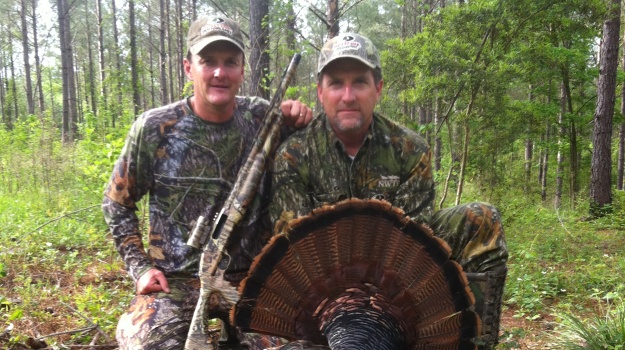
Pictured (l to r): Carsie Young, Bob Dixon, Bill Sugg and Toxey Haas after a successful turkey hunt wearing Mossy Oak's original pattern, Bottomland.
by Ronnie "Cuz" Strickland
I dared not blink while the poacher scanned the ridge for the source of the turkey sounds he had undoubtedly heard coming from my slate moments earlier. The scope on top of the 22 magnum looked ominous through the lens of my video camera, which was zoomed to 14 power. I managed to push the record button and capture the stealth moves of the trespasser as he worked his way closer to my set up. It was obvious that this person was not looking for a gobbler to harvest, so any movement on my part could have been disastrous. I tried not to breathe as the poacher passed with 15 yards of me, still looking for his target. Once past my location, the intruder scanned the open field with his riflescope and then disappeared from view.
When I set up that afternoon on a ridge leading to a large clover field, I had no idea I would call up anything other than the turkeys that had been using that field every day. I was hunting just north of Natchez, Mississippi on land upon which I had permission to film turkeys. The poacher could not believe it when the sheriff showed him the videotape of him sneaking through the woods with his rifle raised on the posted land.
I have been in many situations afield that tested the limits of good camouflage. That afternoon was, without a doubt, the most intense test I have ever endured. Looking back, I probably should have shouted at the poacher from a distance, but I decided to video him instead. Once I saw the intense look on his face and his finger on the trigger of his rifle, I decided to just let him pass. I had no idea he would walk within a few feet of my set up.
I learned two things that day. One was to never think turkeys are the only things listening to your calling. The other was that Mossy Oak camouflage would always be the pattern I wore in the field. To this day, the poacher had no idea that I was sitting against a pine tree with 80 pounds and several thousand dollars worth of commercial video gear in my lap.
 That was back in 1987 when Mossy Oak was just beginning. I purchased my first outfit and also covered all my video equipment with Mossy Oak tape. Camera, tripod, recording decks and microphones all blended into the woods perfectly. The only attention that video camera ever raised was when I strolled into one of my daughters’ dance recitals with it over my shoulder. My wife was not impressed with the great camo job I had done on the video gear.
That was back in 1987 when Mossy Oak was just beginning. I purchased my first outfit and also covered all my video equipment with Mossy Oak tape. Camera, tripod, recording decks and microphones all blended into the woods perfectly. The only attention that video camera ever raised was when I strolled into one of my daughters’ dance recitals with it over my shoulder. My wife was not impressed with the great camo job I had done on the video gear.
Toxey Haas, the inventor of the Mossy Oak pattern, has spent his share of time in the woods in pursuit of turkeys as well. One only has to spend a short amount of time with Toxey to realize that no other person on the planet is more devoted to hunting, especially turkey hunting, than he is. These days, Toxey is also focused on conservation and passing on the hunting tradition but camouflage is never far from his mind.
Mossy Oak was in Toxey’s head years before he developed his first pattern, Bottomland. He confessed to me that even while hunting turkeys as a kid with his dad, he used to dream of being invisible to game. That thought stuck with Toxey through the years and even while in college he never lost sight of his dream to design the perfect camouflage.
Toxey had to learn as he ran with the Mossy Oak idea. He knew nothing about the fabric business, but knew what he wanted in a camouflage. Many suppliers told him that his idea would not fly, or they could not come up with the colors he wanted.
At some point, Toxey put everything together and began sewing the first outfits of Mossy Oak. Once the hunting public saw the product, it was off and running. Toxey said that Mossy Oak has been successful for one reason, and that’s effectiveness. Having known Toxey for decades, I can understand what he means when he says “hunters have made Mossy Oak successful, we always listen to hunters and their needs.”



























